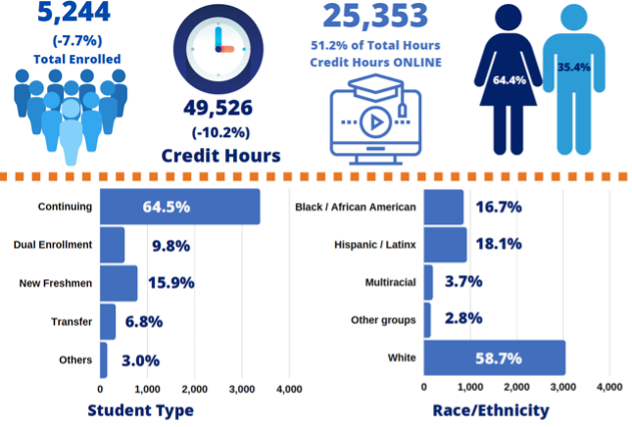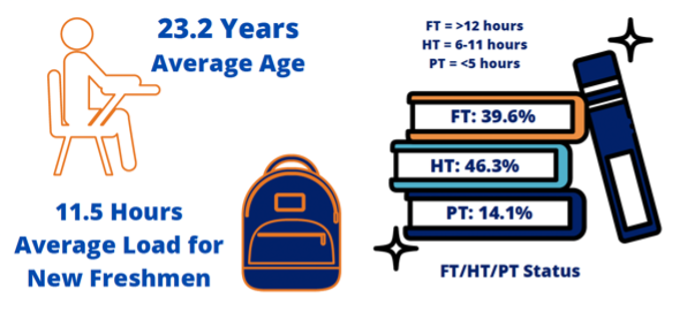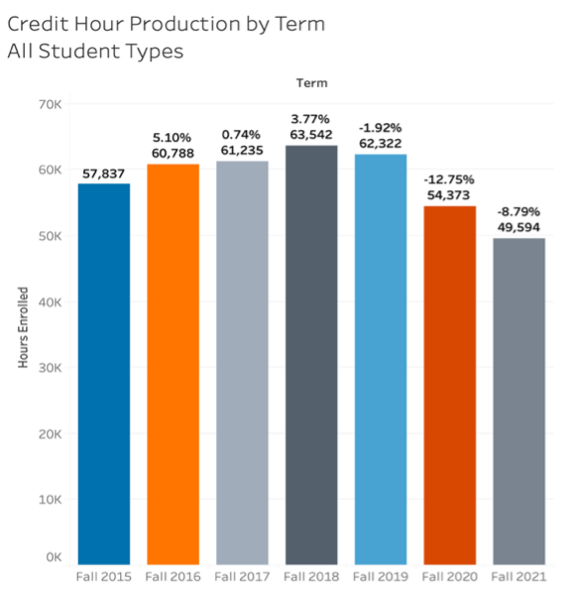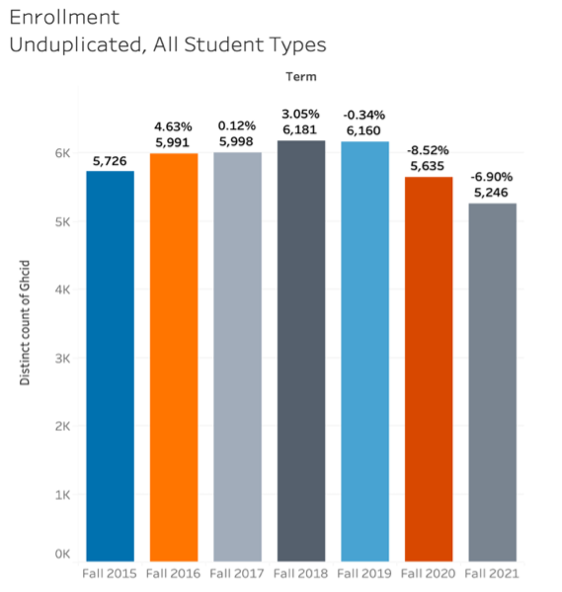Georgia Highlands College Campus Plan Update 2021
SECTION 1: INSTITUTIONAL MISSION AND STUDENT BODY PROFILE
The mission of Georgia Highlands College, a state college of the University System of Georgia, is to provide access to excellent educational opportunities for the intellectual, cultural, and physical development of a diverse population through pre-baccalaureate associate degree transfer programs, career associate degree programs, and targeted baccalaureate degree programs that meet the economic development needs of the region. The college mission influences our work by allowing us to focus on specific programs offered to our students across Northwest Georgia.
Below is an overview of our student body profile for Fall 2021.
Figure 1: Enrollment Demographics.
Data come from internal enrollment reports and may not perfectly match USG enrollment reports, but variance is within an acceptable range.
Our enrollment trends over the past several years were very strong until the COVID-19 pandemic. The graphs below highlight some of those trends. Growth was marginal but steady between 2015 and 2019. In 2020 and 2021, we saw drops in our enrollments due to COVID-19.
Figure 2: Enrollment Bar Graphs, 2015-2021
Data used here are internal GHC data and may not match USG Census Report data. Variance in reporting comes primarily from students who were counted at ADC Census 1 but who received no grade (including W) for the term.
Of note, GHC has seen an increasingly diversified student body. Hispanic/Latinx student populations increased from Fall 2015 to Fall 2018 by nearly 40%. Even accounting for the pandemic, Hispanic/Latinx students increased by nearly 5% from Fall 2018 to Fall 2021. However, Black/African American student enrollment fell by 10% from Fall 2018 to Fall 2021. White student enrollment fell by nearly 20% from Fall 2019 to Fall 2020. We are closely monitoring all groups and thinking about ways that we might better support these students and reduce barriers to their enrollment and completion at GHC.
Pell Eligibility has steadily but meagerly declined in recent years. In Fall 2015, 46% of students were awarded PELL. By Fall 2021, that number was 35%. National data[1] show a similar, but less steep decline with the national average being 34% of all undergraduates being eligible.
In terms of self-reported First-Generation status (FGS), there has been a sharp decline in recent years. In Fall 2018, 2,176 (35.2%) reported FGS. However, by Fall 2021, that number has dropped to 309 (5.9%).
The one-year retention rate for Fall 2020 GHC students was 54.2% at GHC and 59.4% within the USG. Across our sector, state college retention was 52.6% at the institution reporting and 58.3% within the USG. We continue to see our full-time students retained at higher rates (57.4%), supporting the Momentum Approach of fuller schedules. We continue to outperform our sector, as we have for several years. Regarding our QEP, which addresses many aspects of the Momentum Approach, we see our one-term persistence down slightly but still strong at 73.9%, compared to 71.4% for those students not in the QEP. For our one-year QEP retention, we see 53.6% retained versus 47.1% of those not in the QEP.
IMPROVEMENT PRACTICES
GHC undertook several improvement practices related to Momentum. Our improvement practices focused on several key areas: data-informed decision-making, barrier reduction, student support, time to completion, and faculty development.
Our first improvement practice was to do a Momentum activity audit. This audit is being conducted in late Fall term to allow us to better centralize and communicate on our Momentum activities. Using data and results from the Momentum audit, the Office of Institutional Effectiveness and Strategic Initiatives is building a set of Momentum dashboards. These will include data on the strategic foci of Momentum: purposeful choice, productive academic mindset, English and Math in the first term, nine credit hours in the focus area, and 30 hours per academic year.
Next, we identified specific barriers to address with access, enrollment, and completion. As a result, we have had teams working on policy reviews across the institution to identify potential barriers to student access and success. We have a group working on a “Financial SWAT Team” to help reduce financial barriers for students, which includes an in-house payment plan for students, a financial literacy program, an outreach program to provide education to students and families about financing college, and a triage team to assist students who find themselves in challenging financial situations. Finally, we examined barriers to access and success throughout our website. The IT department is completing a project to shop all our webpages for accessibility, currency, and accuracy. We are focused on student-centered language that works to demystify the college experience rather highly codified language that might represent a barrier to underserved populations, such as first-generation students.
Next, we focused on improvement practices related to student support. We revamped our Early Alert system to better identify those at-risk and to provide interventions in a timely fashion. Preliminary results on the Early Alert program showed great results in Fall 2020 and Spring 2021. Feedback from the pilot project was used to modify and strength the Fall 2021 Early Alert program. We will continue to monitor this project. To support purposeful choice for our students, we began creating more up-to-date and robust co-curricular maps to accompany our program maps. Related to supporting students’ purposeful choice and providing access to High-Impact Practices, we undertook efforts to revitalize our Career Services and Internship programs.
To address time to completion efforts, including nine hours in the focus area and thirty hours in the first year, GHC explored ways to promote “15 to Finish,” to serve and support undecided students, and to continue pressure testing schedules. These efforts are aimed at improving practices that might impede a student’s successful, timely completion.
Finally, to help ensure that Momentum practices are engaging all campus constituents, several aspects of faculty development received additional attention this year. While continuing our annual USG mindset survey of students, we incorporated a survey for faculty this year. Our Center for Excellence in Teaching and Learning once again oversaw several Faculty Learning Communities, and our CETL served as the logistical hub for our work in High-Impact Practices.
These groups of projects are all aimed at improving internal processes to support successful student outcomes. They require the broad support of administrators, faculty, and staff. The teams responsible for identifying, developing, implementing, and evaluating these projects include individuals from every level at GHC, from the President’s Office to part-time faculty and staff. These projects were identified through available data, conversations stimulated through the USG Mindset Summit, and through on-campus conversations about specific challenges faced by our students.
BIG IDEA
Our big idea at GHC was to bring our initiatives into one cohesive project to reduce initiative fatigue among our faculty and staff, to improve services across the institution, and to reduce barriers to our students. As noted in our improvement practices, we challenged our campus to pull together various aspects of this essential work. We restructured departments, reallocated resources, and developed specific plans to address specific problems. While this work was distributed across various organizational levels, the work has still been somewhat siloed. In an effort to address this problem, our one big idea to develop a cohesive communication plan grows out a specific need and will improve the overall success of our institution and our students. By clustering the individual activities and communicating about them in an intentional way, we are breaking siloes, increasing transparency, and reducing initiative fatigue by helping individuals realize these projects are all part of catapulting students toward success at GHC.
MOMENTUM WORK RESILIENCE UPDATE
Making our Momentum work resilient has been a challenge and an incredible opportunity. The pandemic highlighted specific weaknesses for our institution, which created opportunities for us to think about serving and supporting students in new ways. We chose the following areas for Momentum Year work: Mindset and Fuller Schedules.
With Mindset, we were able to use the USG mindset survey to extract a subset of questions that were revised to apply to faculty. We created and administered the survey a few weeks into Fall 2021. We had 70 respondents, with 51 of those being full-time faculty, representing just over 36% of our full-time faculty. Over one-half of respondents indicated that they had participated in a faculty learning community (FLC), with 19 respondents indicating that they were currently in an FLC and another 18 indicating they had previously participated in an FLC. We will use these data to compare against previous administrations of the student-facing survey to determine where gaps might exist, allowing us to plan for ways to close those gaps and enhance student success. One such example is that our faculty noted that they were not wholly confident in our students’ abilities to “take quality class notes” or to “talk to college staff.” These areas provide opportunities to help lead workshops for students on note-taking strategies and to provide opportunities for faculty, staff, and students to interact to diminish perceived barriers in communication.
For our work on fuller schedules, we continue to promote “15 to Finish” and robust graduation messaging. Beginning in Spring 2022, students registered for Charger Orientation will be pre-registered for 15 credit hours by default, unless a condition exists that would render this action harmful to the student. Faculty workshops promoting graduation messaging and transfer advising were conducted in Fall 2021. Finally, Quest training now include specific graduations messaging for all faculty participants.
For our work across Momentum Approach, we prioritized the following areas: Heightening Academic Engagement, Deepening Purposeful Choice, and Completing Critical Milestones.
To achieve these aims, GHC looked at several areas for support. One way GHC is heightening academic engagement is through co-curricular programming. By reviewing and refreshing our co-curricular maps, students will have a greater opportunity to connect their in-class learning to out-of-class academically connected experiences. Similarly, the Early Alert program allows for students to get real-time feedback and support to help them engage with their courses, resources, and instructors. Finally, the HIPs implementation team has taken USG recommendation and it continues to develop a plan for implementation and support of a variety of High Impact Practices, which are being supported through CETL. Additionally, since the 2021 Momentum Summit IV and follow-up planning, GHC has hired a new Assistant Vice President of Academic Resources and Retention (AVPARR). With student support services, career services, tutoring, internships, and mentoring reporting to this position, we are seeing higher levels of coordination and collaborative action across the institution. We see this work as important to heightening academic engagement, as well as deepening purposeful choice.
Additionally, new efforts in Career Services and Internship programming support purposeful choice by giving students opportunities to have academic experiences that help them clarify their professional and academic goals. The team leading this effort has assessed the current state of the areas listed below and outlined specific actions for implementation in Spring 2022.
Career Services: a part-time position in career services has been created and was filled in October 2021. Metrics for measuring effectiveness are being developed. For Internships, the AVPARR and chair of Social Sciences are developing college policies and procedures, as well as a database to better support the logistical management of our internship program. Major Mingles are another way that GHC is heightening academic engagement and deepening purposeful choice. Students are given the opportunity to connect with other students and with faculty in the disciplines to ask questions and share concerns about their intended (or possible) majors/pathways. To determine the effectiveness of this program, data are being collected in new ways and shared with the Office of Institutional Effectiveness and Strategic Initiatives to track student performance and progress.
The GHC Entrepreneurship Speaker Series has been highly successful in terms of participation. Another existing program is the mentoring program for entrepreneurship students and a peer-to-peer mentoring program in STEM. Data are being collected now to track student engagement and outcomes.
The Human Library and Alumni Engagement initiatives will begin more formally in Spring 2022. While we had one on campus alumni event in July 2021, we plan to host more of these types of events to better engage our students and maintain networking opportunities. The Human Library project is scheduled to begin in Spring 2022, though some preliminary planning has occurred.
To aid in deepening purposeful choice (and timely completion), GHC began identifying undecided students to intervene and encourage them to choose a major/pathway that is meaningful and will support their educational and professional aims. To achieve this, a team was created to develop training for advisors (professional and faculty) to engage undecided students. In Spring 2022, undecided students who attend Charger Orientation will be given the opportunity to attend a special breakout session to engage and assist them with making a purposeful choice. Undecided students are now being tracked in ways they were not tracked previously. This will allow for monitoring of their success and encouraging them to choose majors/pathways as appropriate to their goals and needs.
With regard to completing critical milestones, Co-Curricular Maps and the “Financial SWAT Team” support students reaching and celebrating critical milestones in their educational journeys. First, realizing that students cannot complete college if they can pay for college, GHC organized a “Financial SWAT Team” to begin developing innovative ways to help students pay for college without going into debt. In-house payment plans, a financial literacy program, outreach initiatives, and a triage unit to help students in challenging situations are the ways in which GHC is working to be resilient for our students. The Alumni Engagement initiative will also support critical milestone achievement by celebrating graduates and alumni in a more visible way on campus.
GLOBAL MOMENTUM SUPPORT
Communication
As noted previously, our communication plan is our one big idea. We are on track to audit our Momentum efforts and to create an infographic to support our efforts. We will schedule several townhalls meetings in the spring to better communicate these efforts. We have given Momentum work several spaces for inclusion in our strategic plan, without explicitly naming Momentum. This allows us to lump efforts together and reduce information and initiative fatigue among faculty and staff who are already stretched thin.
Data
As part of our communication planning efforts, the Momentum dashboards will give us data to guide decisions, but also allow us to tell the GHC Momentum story in a more concise way. Work has already begun to build the dashboards in Tableau and a new Momentum website is being built to house these interactive dashboards.
Faculty and Staff Support
Faculty and Staff are given regular updates about various aspects of Momentum, but as noted, communicating a cohesive story about the efforts has been challenging. As we build the new website and dashboards, we are making sure that our townhalls will allow for wide participation, serving as an invitation to join the many folks already engaged in this work. As noted with our faculty mindset survey, many of the individuals who responded were current or previous participants of FLCs. We take this as evidence that participation in this work is valued by faculty and can impact faculty/staff perceptions and attitudes.
[1] Percent of Undergraduates Receiving Pell Grants. https://nces.ed.gov/ipeds/TrendGenerator/app/answer/8/35






